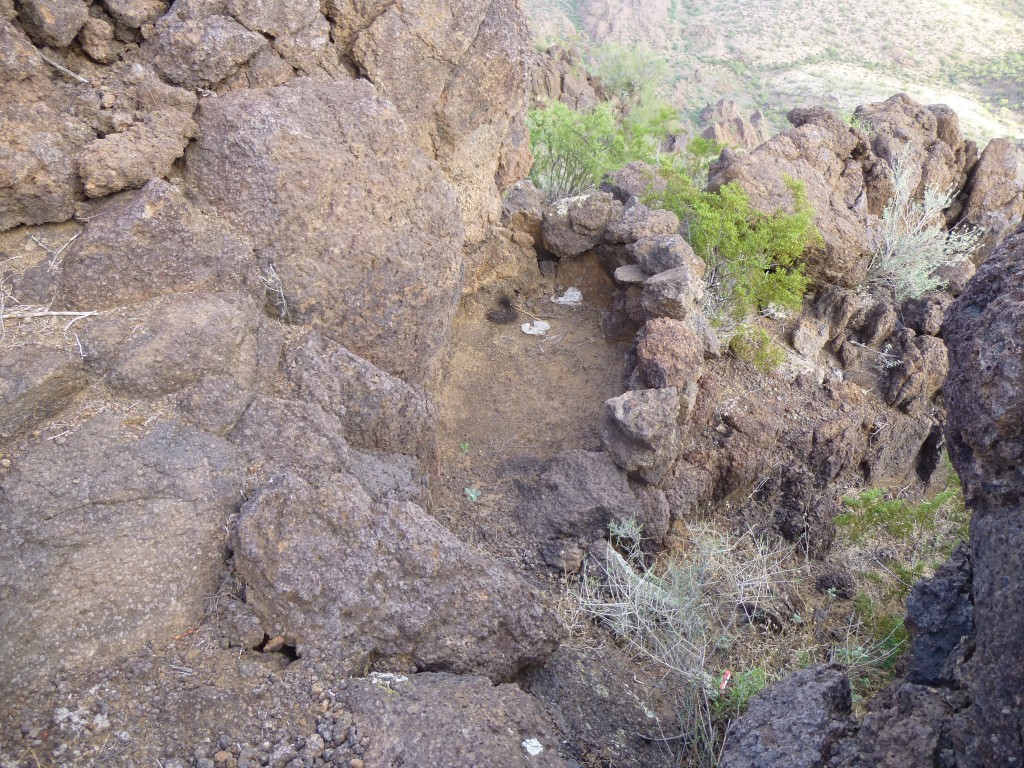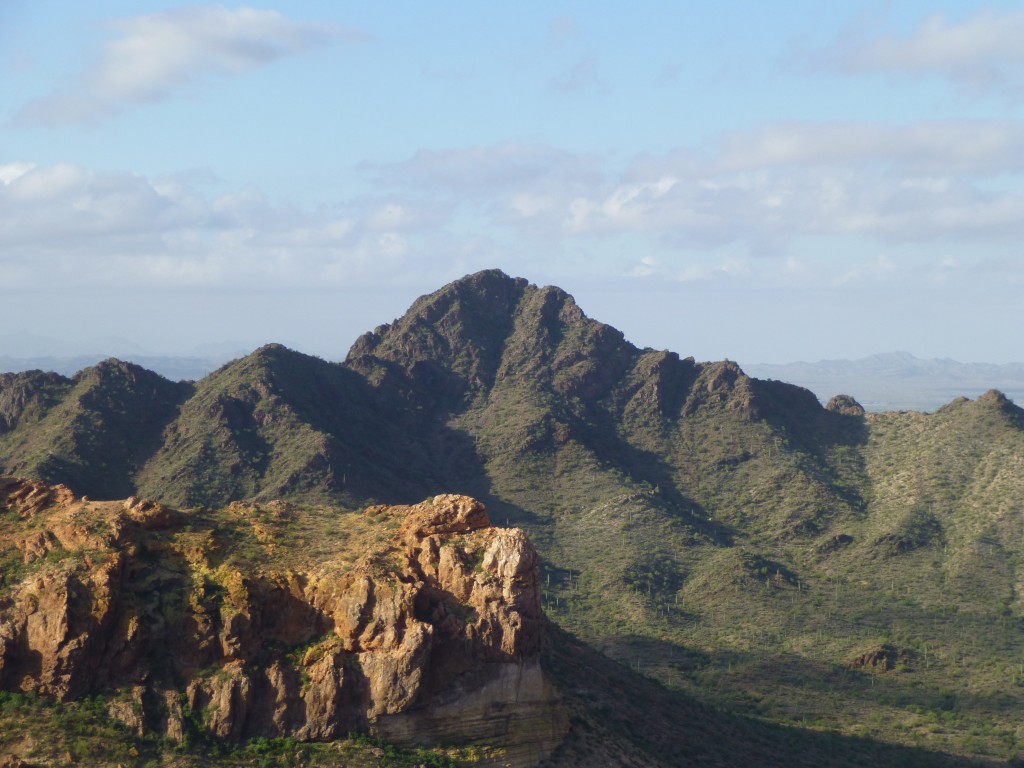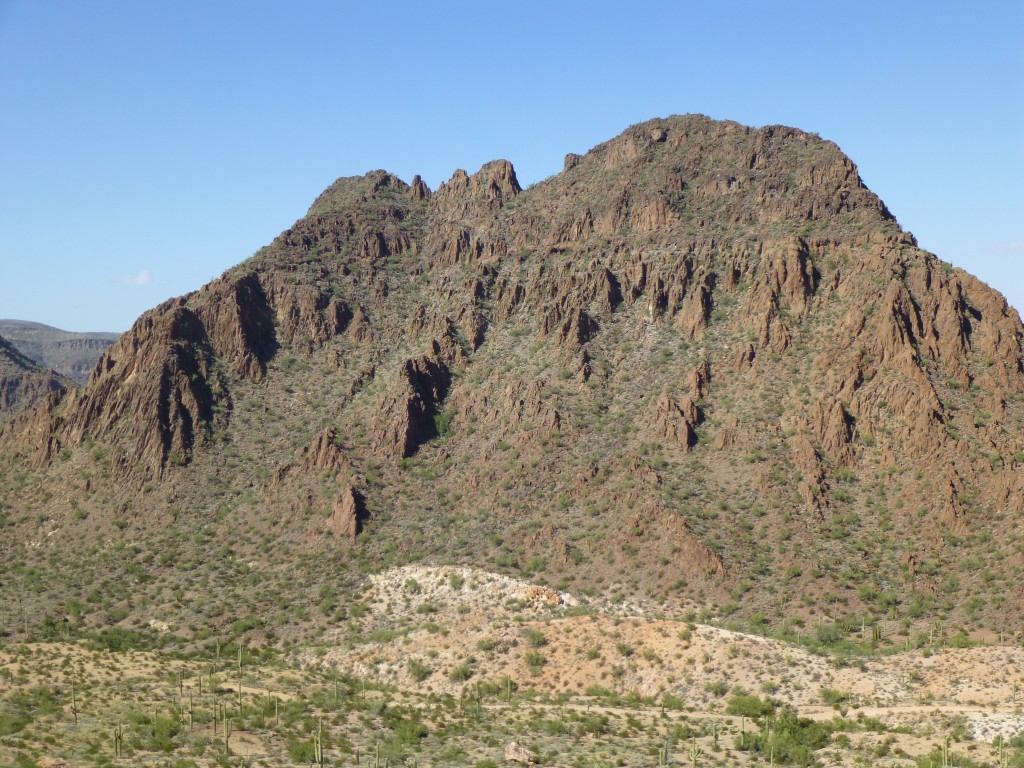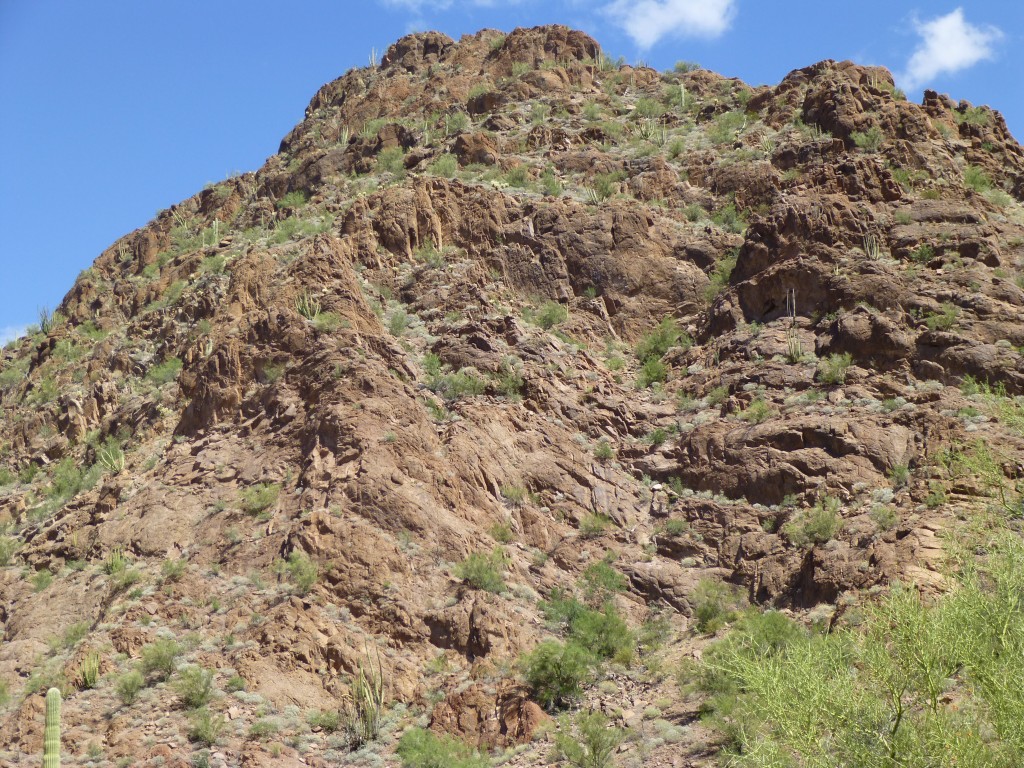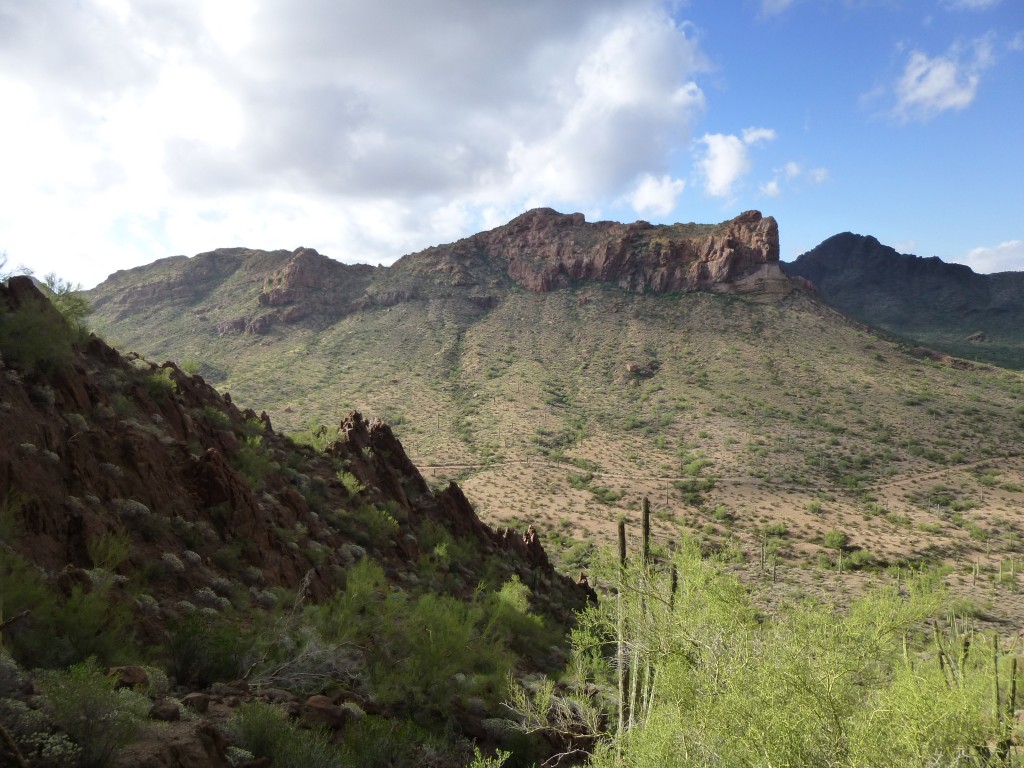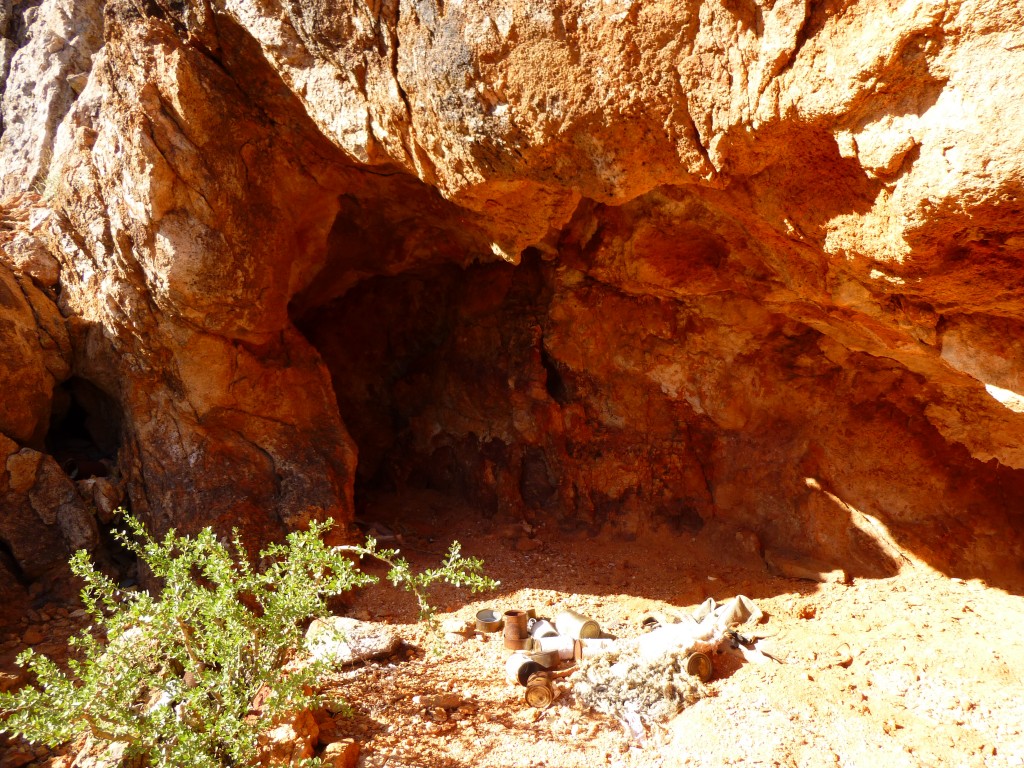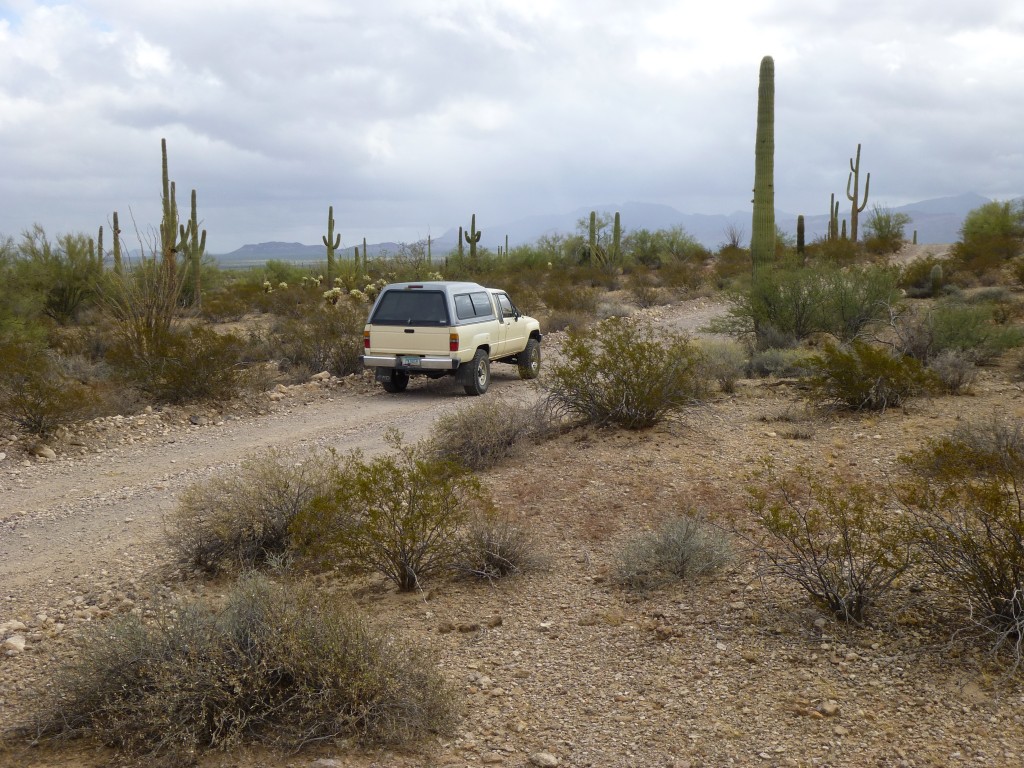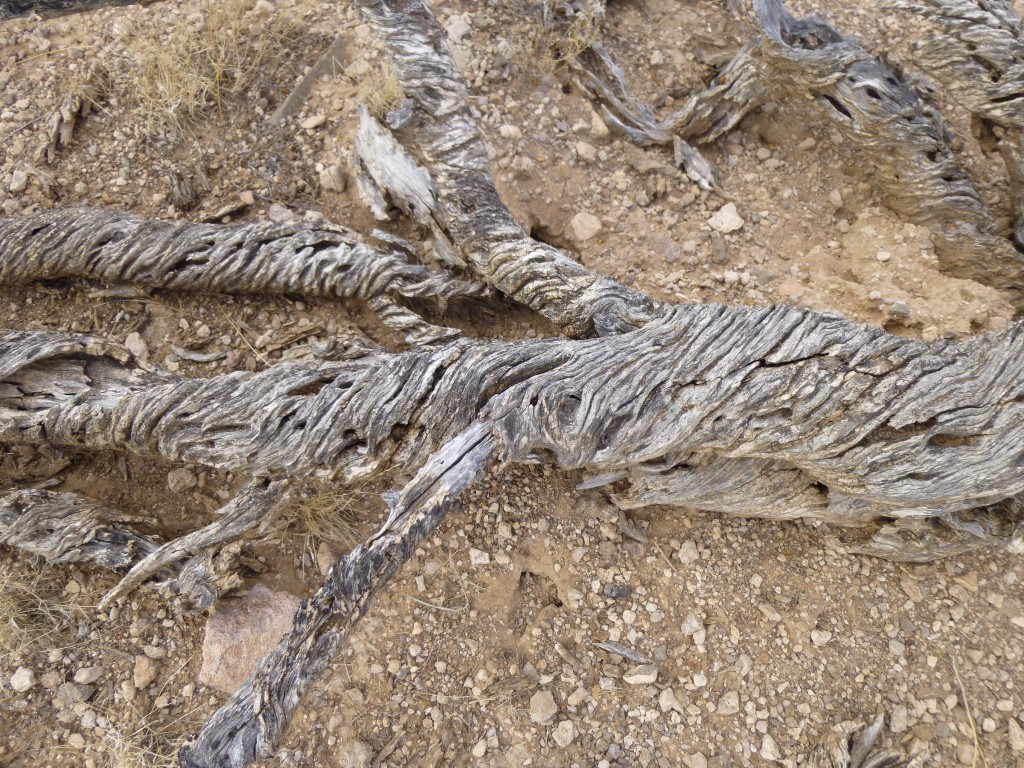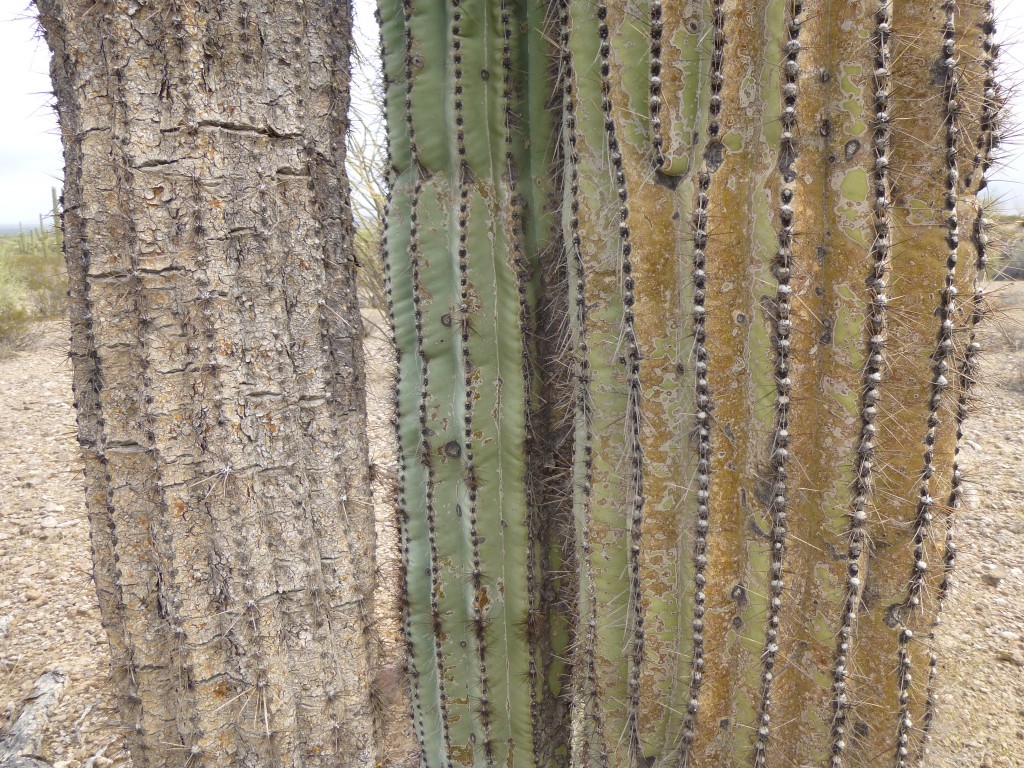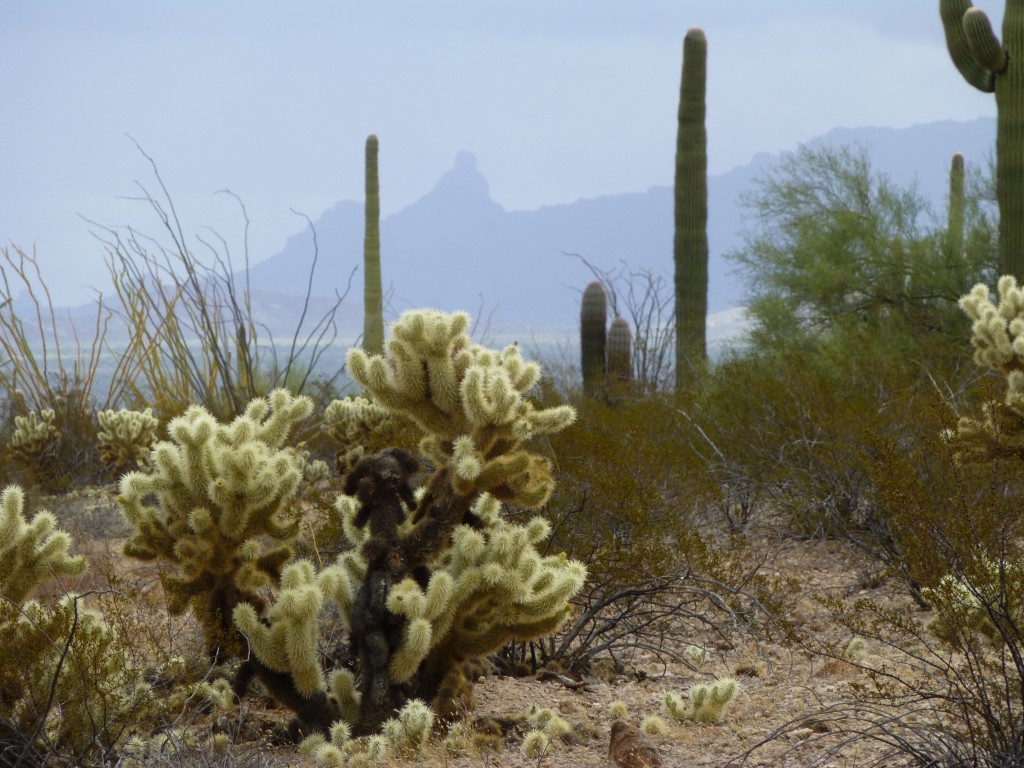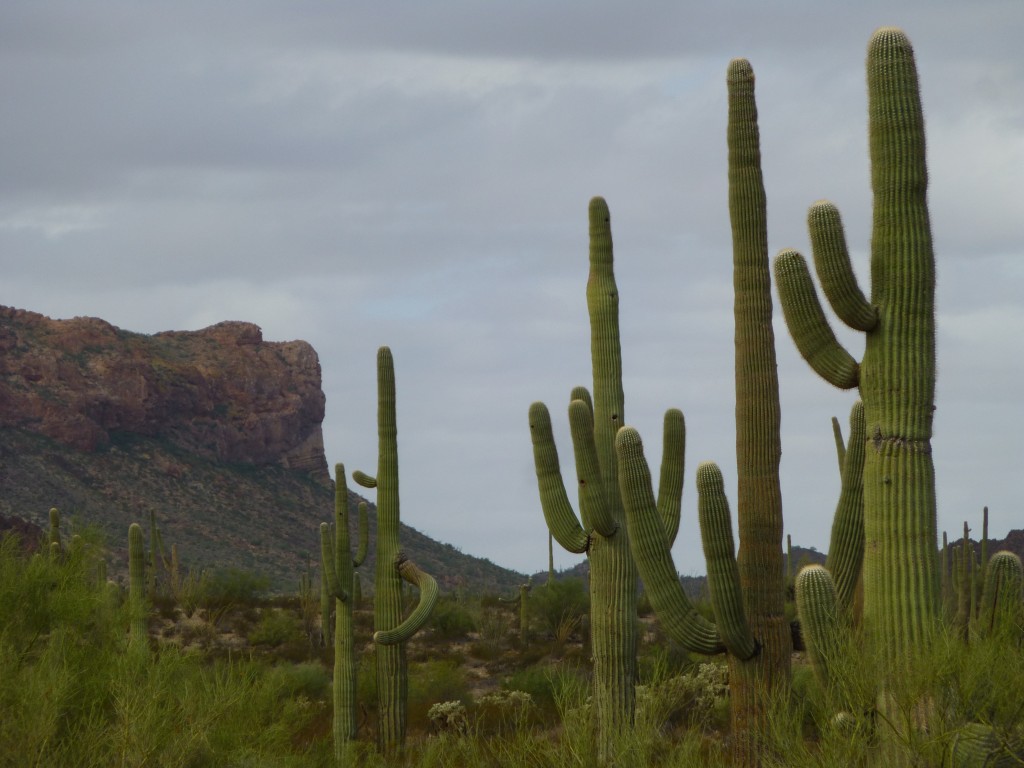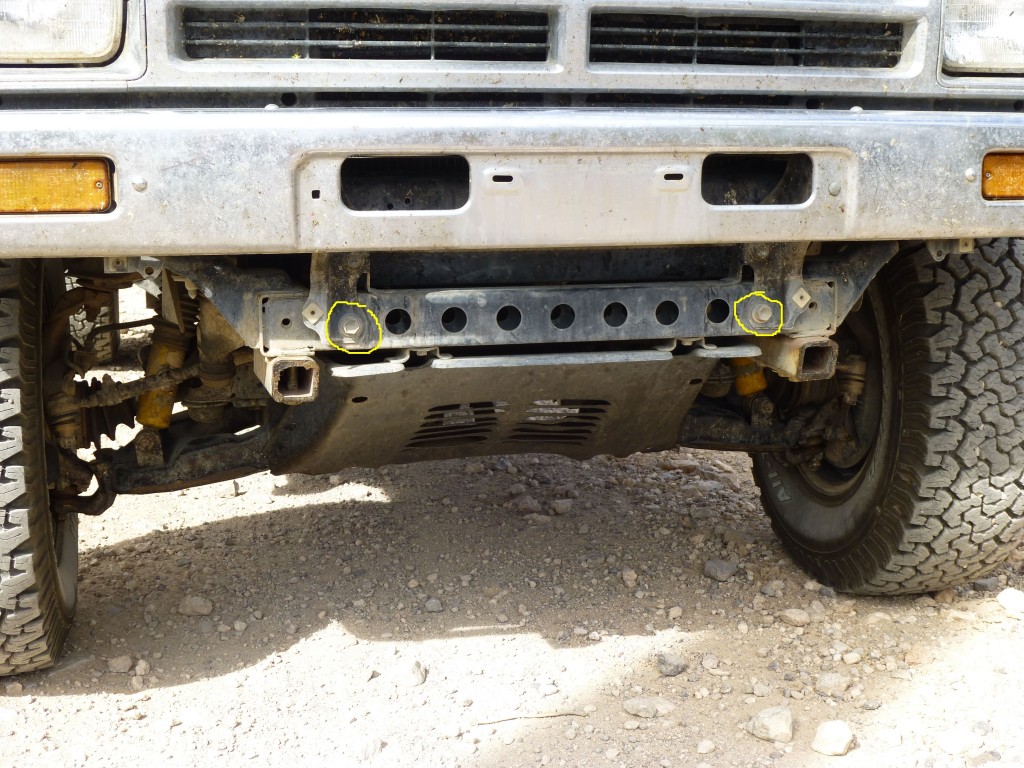The school district in which I work has this thing called “fall break”, where the kids have the week off, and so do I (without pay), so there was only one thing to do – you guessed it, go climbing. I set out after lunch on the Saturday and drove out to Organ Pipe Cactus National Monument, to their big campground near the visitor center. This campground is for real – toilets, hot showers, picnic tables, trash cans – in other words, luxury compared to the primitive camping I usually do. When I arrived late in the afternoon, only one of the 208 campsites was occupied. This is gonna be great – peace and quiet for my six bucks, that’s what I wanted. I turned in early, maybe nine o’clock, and settled in for a good night’s sleep. As I tried to doze off, I heard an odd noise – what the hell was it, surely not the other guy in the campground playing loud music? After a while, as I was getting ready to go check him out and give him what for, I realized that it wasn’t him – it was Mexico!!
Just over four miles away sits the town of Sonoita, across the border in Sonora. They must have been having one helluva fiesta of some sort, because the wind was blowing in just the right direction to carry the sounds of music and voices on a loudspeaker right to my campsite. Even closing myself up in the camper shell of my truck didn’t help. By the time my alarm went off at 4:30, I was plenty pissed off after a lousy night’s sleep. Packing up quickly, I blasted out of there, and just over 15 miles from the campground, along what they call the North Puerto Blanco Drive, I parked at the trailhead for the Dripping Springs Mine Trail. This was merely a convenient place to pull safely off the road – the Desert Mountaineer don’t need no stinking trail to do what he’s gotta do.
Directly across the road sat a steep peak, and as I studied it in the early morning light, I thought I saw a way up it that would work for me. Away I went, and perhaps two-thirds of the way up its south slope, I had to start dodging the many cliffs guarding the summit. My route involved a few moves of Class 3, nothing worse, and in little more than an hour I stood on the top of Peak 2523, about 700 feet above my truck. Sadly, it was trashed by border-crossers – even the register was gone, and I didn’t leave another, as it’d be gone too before long. On the way down, I noticed that the wind was really picking up, and I had to be careful on the dicey bits to not get blown about. I passed this man-made shelter on the north side of the mountain.
On the way down, here’s a view I had of Peak 2675, the second-highest in the Puerto Blanco Mountains.
It was just after nine when I got back to my vehicle. Here’s a view of the peak taken from across the valley in the afternoon. My route angled from the lower left up to the steep-walled notch in the middle skyline.
Nearby were two more peaks that I thought I’d do as a short loop, as they too were close to the road, My new parking spot was a pullout only half a mile from the first, and I left the truck at ten o’clock and headed north. I crossed one saddle, side-hilled for a bit, and found myself on another saddle at the south side of my first peak, where I sat and studied the route.
It looked messy, and possibly challenging to climb from this side, its south. After spending a while memorizing some features on the steep 500-foot slope above me, I thought I’d give it a go. Now I knew that all the way around the other side of the mountain the slope was much easier, but I was too lazy to circumambulate the whole thing to gain so little, so up I went. Maybe halfway up, things started to get interesting – there were cliffs everywhere, and I had to become the artful dodger to weave a way among them to keep climbing. Once it started to get tricky, I started to leave a series of ducks as I went. A duck is simply a stack of stones (two or three high is sufficient) which can be spotted one from the next, kind of like a trail of wands on a snow slope. There were several spots where I had to make an abrupt change of direction in order to continue, and others where I was forced to travel laterally for a while, or even drop down a bit. It all ended well, though, and on the summit of Peak 2263 I found the register placed there 17 years before by Bob Martin and Richard Joseph. I signed in and even managed a call home before starting down. The winds had really picked up, and were now blasting the mountain-top with gusts of such force that I feared getting knocked down in dangerous spots.
Soon after I began, I realized that without those ducks, I’d have been in a world of hurt. There were so many changes of direction that nothing seemed familiar – just when I thought I knew what was coming next, I’d be wrong. Climbers are always wary of getting “cliffed out”, meaning you come to a spot where you cannot safely downclimb without a rope. This can cause an inconvenience, to put it mildly, and a major hardship under the right circumstances. Needless to say, I made it down okay, and took a break in a shady spot in the canyon below.
It was short work to climb the 400 feet the top of Peak 2090, where I was happy to find another register. After signing in and admiring the views, I headed down and was back at my truck by 1:30 PM. There was one more mountain to climb to finish off the day nicely, and from where I parked for it a while later, it looked like a walk in the park.
The first 400 feet were a stroll, but when I reached a saddle, I saw I’d have to drop down some in order to continue the climb. As I did, several caves came into view, and it was obvious they’d been used by border-crossers as they played their waiting game.
On the summit of Peak 2435 was a lot of trash, and of course the register was long-gone. Bob Martin, who had left many of the registers in Organ Pipe, would be saddened to know how many of them had been destroyed.
Once back down at my truck, I was looking forward to cooking a meal at the campground, but as I motored along something unexpected happened – while driving on a good level patch of the dirt road, without any warning my engine died, just like that. To say I was shocked was putting it mildly – nothing like that had ever happened before with that truck. I tried several times to re-start it – it would crank okay, but no ignition. Now I’ll be the first to admit that I’m a mechanical numbskull – I was one of those kids who never took auto mechanics in high school, and never really tried to learn about what goes on under the hood. I always paid others to fix my car problems, and now I was about to pay the real price.
Miraculously, I was able to make a cell phone call, even from down here on the desert floor. The first person I called was Greg, my mechanic. Once I explained to him what had happened, he said that normally there are only two things that could cause such a failure – the igniter or the fuel pump. So here were my options as I saw them:
1. I could wait for someone to come by and perhaps tow me (I had a strong nylon tow-strap) the eleven miles to the park’s visitor center, which was right by the paved highway. If I made it that far, perhaps there was a tow-truck at Lukeville, the Port of Entry six miles farther south, and they could tow me to the service station, where maybe there was a mechanic, who could maybe diagnose the problem. He could order parts, which would have to come from Phoenix, 150 miles away, but I was leery of some guy who I didn’t know messing with my truck. Back in 2001, I was in this area and needed a new alternator – I had a shop in Ajo, 38 miles to the north, replace it – it took 4 days, and they put in a piece of crap which failed 6 months later. So, option #1 had a lot of ifs.
2. I could fiddle with it myself, in the vain hope of a miracle happening, but that wasn’t realistic.
3. Maybe someone could tow me all the way to Tucson, right to my mechanic. Right, what are the chances of that? When pigs fly, I think.
I called home and told my better half what had happened, then told her I’d get back to her later when I had a solution figured out. Then I made one more call, to my friend Paul in Green Valley, Arizona. As soon as I explained what had happened, he didn’t even hesitate – he offered to drive the 200 miles from his home out to where I was and help me out. He said he had a sturdy tow-bar that he hoped we could attach to my truck and with his large Toyota Tundra pull me out to pavement and then back to town. What a stroke of good luck, and what a friend! All I needed to do was wait. Paul said he’d call me back early the next morning to discuss the details.
I spent a restful night, secure in the knowledge that tomorrow would bring a happy ending. It was maybe 4:30 PM when my truck died – it sat there in the middle of the road all night long, and nobody came by. The next morning at 8:00 AM, I called the Organ Pipe HQ and told them I was stalled in the road and my friend was on his way. No problem, they said one of their law enforcement people was on his way and would stop and check on me in an hour (he never did). Knowing I had hours to kill before Paul arrived, I did something I rarely allow myself the luxury of doing – camera in hand, I walked through the desert and took pictures of little details that I usually just walk right past. I’d like to be a better photographer so I can show you more of the beauty that abounds here. A peakbagger’s life is usually one of haste – so many mountains, so little time – do one, move on to the next, do several in a day if possible. Little time to smell the roses, or, more correctly, the cacti. This forced interlude gave me a chance to casually walk around and examine some of the little details I usually ignore in my hell-bent rush to get from one peak to the next.
Some time after eleven, a Border Patrol officer pulled up and said “your friend will be here soon, I passed him on the road”. Sure enough, a short while later Paul pulled up – man, was he a sight for sore eyes! He examined the front of my truck, and soon discovered that his tow-bar couldn’t attach in the normal way to the frame on the front of my truck. Not good. Paul, being the industrious fellow he is, soon discovered an alternate way we could hook it up. If you look at the next photo, you can see the two bolts I’ve circled in yellow.
To make a long story short, the whole affair was hooked up to just two bolts on the front of my frame – it looked shaky at best, but once it was done we drove a short way, then stopped and checked it all over. So far, so good – we tightened things up a bit, then carried on. There were some rough patches, and even a few washes to get through, but by the time we covered those eleven miles to the visitor center, we were convinced that it was gonna work.
Well, to make a long story even longer, it was 7:00 PM by the time we dropped the truck off at my mechanic’s shop, and a bit later when Paul left me at my door. The next day, Greg called me to say he’d found the problem, and it was totally unexpected. There was a large resistor, and a wire connecting it to the fuel injection system had broken clean through – there was no way any spark could get to the spark plugs. He soldered it and the problem was solved right away – I never would have found it, not if my life depended on it. Greg told me that those two bolts were so strong that you could have lifted the truck with either one of them, so Paul had made a good choice to use them.
I dodged a bullet this time. If I’d made the choice to drive in the other direction, away from the campground instead of towards it, and then broken down, in a short time I’d have been out of cell phone range. Man, I’d have been so screwed. Go far enough on that road and you’d have to walk many miles to be able to make a call again. My situation would have become a lot more complicated in a big hurry. Thanks again to Paul for saving my sorry ass.
Please visit our Facebook page at: https://www.facebook.com/pages/Desert-Mountaineer/192730747542690

